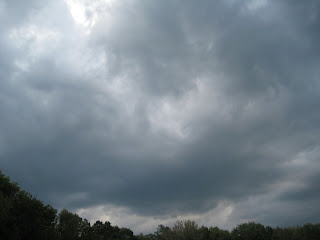 |
| A mild storm in upstate New York |
Although New York’s Capital Region was spared any serious weather issues due to Hurricane Sandy, I have lots of family and friends facing really difficult times ahead. No power, trees down, houses damaged. Today I’m sending out prayers to all of them and everyone else whose lives have been turned upside down by the storm.
So often, when things like this happen, we find ourselves questioning. Why? Why here? Why me? Why not me? All of that made me think of a passage from my new book, so I thought I’d share it here today even though my book will not be released until one week from now.
Excerpted from Everyday Divine: A Catholic Guide to Active Spirituality, Chapter 6:
The recent spate of unusual weather across the country and around the world — tornadoes in unlikely places, blizzards where it should be warm and heat where there should be blizzards, hail and wind and earthquakes — serves to highlight the less-beautiful and more-dangerous aspects of God’s creation.
Why would God allow such violent and frightening elements into a universe he set in motion? Why not maintain a placid natural world where everything works for humanity’s benefit?
The Catechism of the Catholic Church explains that God created a world that is “journeying” toward perfection, meaning it’s not perfect yet. Good and evil must co-exist in this imperfect world.
“In God’s plan this process of becoming involves the appearance of certain beings and the disappearance of others, the existence of the more perfect alongside the less perfect, both constructive and destructive forces of nature,” the catechism states.
On a logical level, you can probably make an argument for that reasoning, but if you happen to be the person watching your home and all your belongings get washed away in a flood or torn apart in a tornado, it becomes a little more difficult. Where is God, you may wonder, when you see images of people desperate to escape a tsunami a world away or a raging wildfire in the next town?
When confronted with nature’s fury, it’s normal to turn to God for protection, for answers, for comfort. There are even special prayers written specifically for such occasions. When I was heading to Rome several years ago, my plane was expected to depart New York’s JFK airport the exact time Hurricane Earl was expected to arrive there. As I headed for the airport shuttle bus in Albany, already nervous since I was going to Italy alone and hadn’t been overseas in 25 years, I swore to every member of my family that if someone swooped down and offered to buy my ticket, I’d gladly bow out. I didn’t want to mess with a hurricane during take-off.
But no one swooped in to take my ticket off my hands, and so I nervously arrived at my shuttle bus. Being a chatty sort, I went up to three people standing together to see if I happened to be in the right place. It turned out they, too, were going on a pilgrimage — to Lourdes, France — and they offered to watch out for me until I arrived at my Alitalia gate. But more than that, sensing my nervousness over the weather, one woman gave me her prayer book, marked to the page with “The Prayer of Blessing Against Storms.”
“…Christ conquers. Christ reigns. Christ orders. May Christ protect us from all storms and lightening. Christ went through their midst in peace, and the word was made flesh. Christ is with us…,” I read from the little nameless blue prayer book with the image of the Pieta on the cover.
As I sat on the shuttle, reading from my new prayer book and marveling at the way God intervenes in the minutia of my life, I felt a calmness descend, and I realized that my pilgrimage had already begun, right there at the shuttle bus stop. By the time we got to the airport, the skies had cleared a bit, and my flight left on time. In fact, I arrived in Rome a few minutes ahead of schedule.
God can’t stop the storms, but he can see us through them.
(This is taken from Chapter 6: Sounds and Signs of the Spirit. Everyday Divine will be released next Tuesday, Nov. 6, and is available now as a pre-order through Amazon.)
Copyright 2012, Mary DeTurris Poust. No portion of this may be reproduced without permission from the author.







